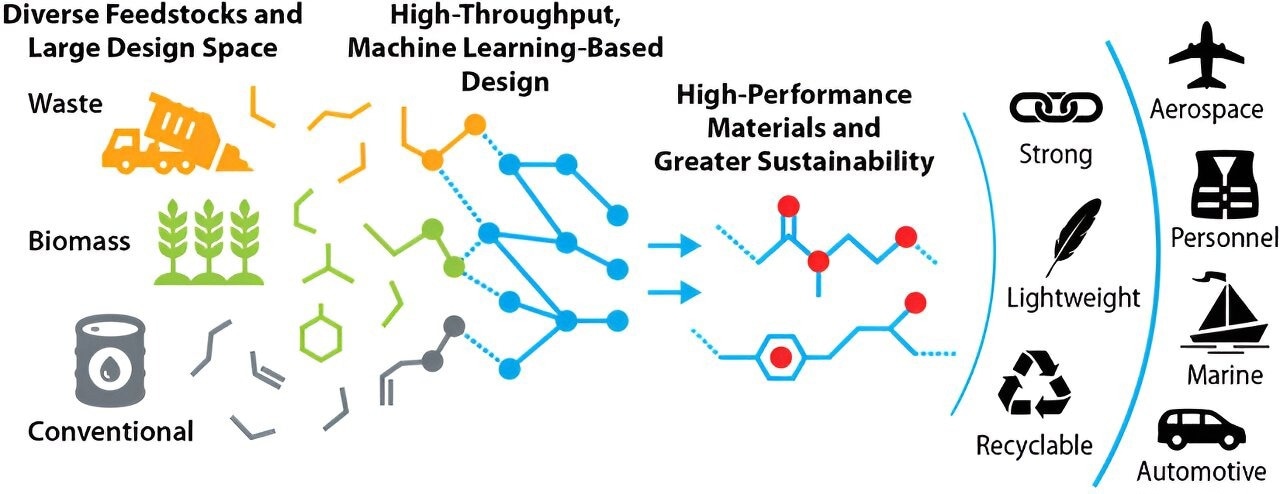
PolyID revolutionizes materials discovery by making it faster and easier than ever to find sustainable and high-performance polymers for a given application. Image Credit: Elizabeth Stone, NREL
In the 21st century, the primary challenge for material scientists lies in discovering the ideal formula to create polymers that are simultaneously more sustainable and higher performing, particularly when working with limited petrochemical resources.
Petroleum largely comprises hydrocarbons essentially arrangements of carbon and hydrogen chemically linked together that have some pretty remarkable and advantageous properties. But hydrocarbons lack heteroatoms like oxygen and nitrogen, and it can require significant energy to add them in when manufacturing polymers needing broader functionality than what hydrocarbons provide.
Brandon Knott, Scientist, National Renewable Energy Laboratory (NREL)
A viable solution, as explained by Knott, involves incorporating oxygen- and nitrogen-rich biomass and waste into the mix. Materials such as corn stalks, algae, and even waste materials offer additional chemical linkages, providing chemists with greater flexibility to achieve specific properties.
However, pinpointing the precise recipe that combines sustainability and top-notch performance can be a complex endeavor.
To simplify this process, the National Renewable Energy Laboratory (NREL) has developed a machine learning tool called PolyID: Polymer Inverse Design. Using artificial intelligence, this tool can forecast material properties based on molecular structure, enabling it to efficiently assess millions of potential polymer designs and generate a shortlist of candidates suitable for a given application.
The tool's details are extensively discussed in the journal Macromolecules.
Smart Algorithm Connects Material Properties to Molecular Structure
The algorithm powering PolyID represents a cutting-edge enhancement of the fundamental concept known as "group-contribution theory." This tool establishes links between the configurations of elements such as oxygen, hydrogen, carbon, and others and material characteristics, enabling the prediction of attributes like elasticity, heat resistance, and sealing performance.
With a growing library of connections between the molecular structures of polymers and their known properties, it "learns" to predict how new polymers might be designed to achieve specific physical characteristics.
If you do that with a few thousand polymers to train the algorithm, you start to get accurate predictions for structures that haven't been seen before by the algorithm and maybe haven't been made before.
Nolan Wilson, Lead Author, Renewable Resources and Enabling Sciences Center, NREL
Equipped with a reference library containing thousands of polymers, this tool empowers scientists to approach new polymer designs in a reverse-engineered manner. They can first pinpoint the desired properties and then choose among potential polymer designs that align with these specifications.
Case Study: Finding Biodegradable Alternatives to Today's Food Packaging Films
NREL scientists utilized PolyID to efficiently screen over 15,000 plant-based polymers, aiming to find biodegradable alternatives to current food packaging films. These films, typically made from petroleum-based high-density polyethylene, are engineered to endure high temperatures and maintain a strong vapor seal for food freshness.
In their search, the NREL team used PolyID to prioritize these key properties while also seeking additional beneficial attributes like biodegradability and a reduced greenhouse gas footprint. The tool generated a concise list of seven polymer designs derived from biomass.
Subsequent lab testing validated the tool's predictions. Each of the seven polymers not only withstood high temperatures but also contributed to lower net greenhouse gas emissions and extended the freshness duration of food items.
A Tool To Tailor Polymers To Industry Needs
The prospect of designing new polymers with a focus on sustainability presents a significant challenge, even for the most skilled chemists, especially considering the millions of unique materials derivable from biomass, waste, and conventional feedstocks.
This challenge is amplified by growing consumer demands for more sustainable products. In response, many companies are innovating to reduce waste, enhance recyclability, and lower their carbon footprints. However, achieving these sustainability goals without compromising on product performance is a complex task.
PolyID stands out in its ability to balance performance with various other sustainability considerations, as highlighted by Wilson. The tool adeptly navigates this delicate interplay, offering solutions that meet both environmental and functional requirements.
Some of these might serve as direct replacements for comparable petroleum polymers. But, in many cases, they are even better in terms of performance and sustainability.
Nolan Wilson, Lead Author, Renewable Resources and Enabling Sciences Center, NREL
That way, food packaging can do more than improve shelf life. The coatings on a pair of skis will not only help ward off cold and snow. The thermoplastics shell in a bike helmet might protect more than your brain. They can do that while supporting a healthy environment, too.
Journal Reference:
Wilson, N, A., et al. (2023). Artificial Intelligence for Discovering Performance-Advantaged and Sustainable Polymers. Macromolecules. doi.org/10.1021/acs.macromol.3c00994